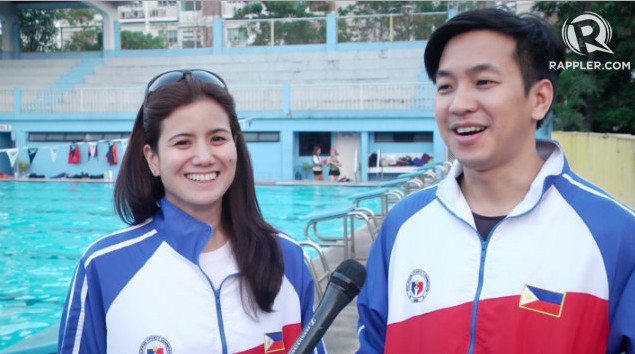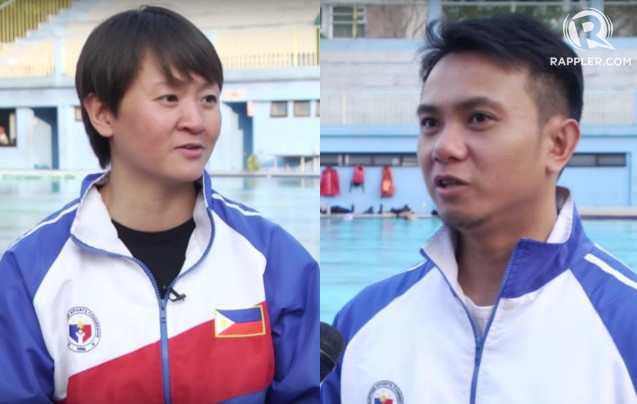Philippines Underwater Hockey Team – Ten gold medals, 7 silvers, two bronzes, and 3 World Championship appearances spanning two decades of international competitions.
The Philippine Underwater Hockey team has been bringing pride and glory to the country for the longest time in battles won beneath the surface, and they remain largely off the radar.
Team members slowly trickle in at around 4 pm on a Saturday afternoon, just as the summer sun’s heat becomes bearable. The Olympic-sized swimming pool at the Philippine Sports Commission in Pasig is still checkered with public users.
By 5 pm, the pool is empty and personnel begin to move aside the lane dividers to make way for the underwater hockey “court” at the bottom of the pool. A couple of 3-meter wide stainless steel or aluminum goals are then lowered into the water, with the playing area roughly a third of the pool.
Soon, the national team players emerge from the changing rooms in their swimwear. Each one puts on the sport’s basic gear: a mask, snorkel, fins, ear guards, padded gloves, and mouth guard.
The team members forget the day jobs they have to maintain, put their game faces on, and disappear into the pool’s depths.
“In international games usually they have cameras underwater for livestreaming and the audience just watches it on screens above the water,” Chari May Ongyanco, 38, who – when she’s not team captain of the Philippine women’s team – works as an operations manager for a printing company, answered one of the very first curiosities about underwater hockey.
Her explanation underscores a key challenge to the development of the sport.
“It’s hard to actually promote it because it’s a non-spectator sport. We’re hoping that it’s easier to get livestreaming so people can watch our game to pique their interest.”
The game
Underwater hockey is thought to have been in the Philippines since at least the 80s.
Players use a short stick to try and push a puck inside the goal during two halves typically of 10 to 20 minutes in length, depending on tournament rules. The 6-on-6 game is mostly similar to the popular ice or field hockey – except that it is played at the bottom of a swimming pool.
Women’s and men’s team captains Chari May Ongyanco and Ray Bejar. Photos by Rappler
“The real, real, real difference is while playing we cannot talk to each other. The only way to communicate is actually by feel in a way,” explained Ongyanco. “Another big difference between our sport and other (types of) hockey is while playing you’re holding your breath.”
As players expend energy diving, swimming and jockeying for possession of the puck 6 to 8 feet underwater, two to 3 water referees float around officiating the match. A deck referee is outside of the pool together with a scorer, a person in charge of the audible sound, and the time-keeper.
“Underwater hockey is actually a non-contact sport,” said Ongyanco. “So you can only move the puck using the playing area of your stick. If you use your hand, your foot, your body to move the puck, that’s a foul.”
“It’s also a foul to hit a person, even if it’s unintentional. If you hit a person using your stick that’s a foul because you can only aim for the puck,” she added. “Of course no grabbing, obstruction, screening, dangerous flick. There are a lot of fouls.”
Once a foul is called, the water referee makes a hand signal to the deck ref, who will then call for an audible sound to signal the foul. Play is stopped for either a penalty, an advantage puck, or an equal puck.
Penalties include being sent to the penalty box beside the deck ref for one minute, two minutes, or even 5 minutes. Once a player is penalized, the team goes on with the remaining 5 in the pool with no substitution allowed.
“Sometimes a team plays 4 against 6 because their players are penalized,” Ongyanco noted.
Success, but no exposure
Members of the Philippine national team pop up above water for daylight and air then go back down again continually as their Saturday training wears on. There are no underwater cameras projecting livestream images at the PSC pool. But some elevation atop the nearby high dive tower offers a unique top view of the game.
The puck is barely seen amid the cluster of players vying for it, but movements – swift, aggressive, and one could say even mermaid-like – beneath the pool are visible. The irony of just how difficult it is to catch a glimpse of this sport and this team playing is certainly not lost.
A Philippine team was first sent to compete internationally at the Pacific Coast Championship in Canada in 1995. The squad took home the sportsmanship award that year. They returned in the next two years, getting better each time with a 4th place finish then a silver medal finish in the mixed team category.
At its first Underwater Hockey World Championships stint in 1998 in California, the women’s team bagged the Fair Play award. Six years later in 2004, the Philippines was back on the world stage in New Zealand but did not win any awards.
A decade later, Filipinos flew to Stellenbosch, South Africa for the 2016 Underwater Hockey World Championship from March 23 to April 2, where the Men’s Masters team placed last in a field of 9 and the Women’s Elite team finished 13th in as many squads.
Team member Mara Guevara admitted there was disappointment on their part “as we feel that we could have done better” but said they managed to improve their scores by 25 to 30%, even as they had little time to acclimatize to playing in a deeper pool and much cooler water heading into winter.
“The hockey community is a relatively small community, so it was nice to hear the other countries recognize our skills and potentials,” Guevara told Rappler.
Finding funding, time to train
In Asia, the Philippine team is among the top competitors, snagging 7 golds and 3 silvers across men’s and women’s divisions in the Asian Tri-Nations Cup and the Asian Underwater Hockey Championships since 2007.
In spite of all that success, the team is largely unheard of with the sport’s non-spectator nature, little to no media exposure, a modest grassroots program, a sparing training program, and subsistence on limited financial backing overall.
“We were lucky enough to get enough supporters, friends, sponsors and individual contributions financially so that’s why we were able to come up with a fund to compete in the worlds,” said men’s team captain Jay Bejar.
To boost finances, the team put up a profile on fund-raising website ambag.ph, where they raised P585,000 of the target P1million. Including corporate sponsorships and donations, the team raised approximately P650,000 for their trip, according to Guevara. All of which “helped lessen each player’s expenses.”
Funding is a major obstacle as well in simply getting a coach. As it stands, the team relies on a playing coach, who is usually one of the veterans. The set-up, according to Ongyanco, also has an adverse effect on the sport’s rise with a lack of expertise to help widen its reach.
To compensate, the team occasionally puts together training camps locally and invites an international coach to instruct. The team invests more on small international tournaments for competition, rather than flying everyone out of the Philippines purely for training.
There are currently 4 underwater hockey clubs in the Philippines: the Polo Puck Pirates (the biggest in Manila and is based at Ultra or sometimes at Army Wellness in Fort Bonifacio), the Puerto Princesa Proud Peacocks (based in Palawan); the Citadel (based in Parañaque); and the UB Seals (based also in Fort Bonifacio).
Each club does its best to meet and train as regularly as possible and helps spread the word about underwater hockey – even when time is scarce. The Pirates, in particular, are mostly comprised of members deep into their respective careers in other fields.
Between busy schedules with work, family, and personal lives, the Pirates, essentially the national team, squeeze in 3-a-week training sessions of two hours each, usually at 5 pm on Tuesdays, Thursdays, and Saturdays after most business hours. That training schedule offers as much insight into the need for a financially sustainable national squad as it does the level of commitment and dedication it takes for this team to survive and thrive.

Anne Biemann (L) and Christopher ‘Topz’ Policarpo are members of the Philippine underwater hockey team. Photo by Rappler
Christopher “Topz” Policarpo, for instance, juggles his national team duties with his day job as a cabin crew. He started playing in 2010 and at 35 years old, Policarpo, who looks forward to the good kind of physical exhaustion from playing, is the youngest member.
On the other hand, Anne Biemann, 39, is a photographer outside of the pool. She keeps coming back for the challenge the game poses.
The energy at training is high even after a long day of work for some. Then again, limited practices also pose drawbacks in terms of discipline and consistency.
“The time is the hard part here because we have to balance our time for work, time for training. Sometimes as much as you want to train you can’t because there are a lot of factors that affect your training time,” explained Ongyanco. “I cannot say that we train really hard because it’s hard to do 100% training for this so we can just do as much as we can.”
Charting the future
They, too, are doing the best they can in promoting underwater hockey and laying down the foundations for its place in the Philippine sports landscape in the future.
They’ve started with yearly grassroots programs supported by the PSC, where they go to different parts of the country to introduce the sport to communities and recruit. The Puerto Princesa club was formed as a result of a grassroots program there. A likely next stop is Cebu.
“I think we saw that we have to concentrate on areas close to the water, like Cebu, where many grew up by the sea,” said Ongyanco in Filipino. “As Filipinos since we’re surrounded by waters, it should be our advantage because we have plenty of good swimmers. Actually even if you’re not a good swimmer, as long as you’re not afraid of the water you can excel in underwater hockey.”
The objective is to sustain the annual programs in order to “recruit, and start young, so when they grow up their potential would be really high.” The hope is to one day have a streamlined development program headed by professionals.
Part of the future they are charting is “making underwater hockey available especially to those colleges part of the UAAP,” said Bejar.
“It’s still on the planning stage,” he clarified. “It’s still with the organization, with the Philippine Underwater Hockey Confederation Board, because it’s going to be quite challenging to do that. We don’t know yet the whole picture but it has already been talked about for quite some time.”
“For now we just do introduction to underwater hockey. Independent recruitment for now. But yeah, that’s the best thing to do – to put the sport in schools nationwide,” he added.
Independent recruitment is done also by open invitation for anyone to go to practice, learn about the sport, and try it out for themselves.
The team posts available schedules on its Facebook page and on its website and people – regardless of age, sexual orientation, or background – can “just show up and we teach them the basic skills to play. Afterwards you can join our games so you can continue playing the sport.”
After the world championship experience, the national team now sets its sights on the Manila Invitational Hockey Tournament set for the first quarter of 2017, where players from around the world will fly into Manila to compete.
The Asian Championships come around once more towards the end of 2017, where the men’s team will vie to reclaim the gold while the women’s team will defend the gold from last year.
The sun has set, the skies are a dark shade of blue, and the massive PSC field lights are turned on one Saturday summer afternoon. After a round of girls versus boys, with the lights piercing the blue pool, one by one the players rise to the surface.
They mill about, conversing, then hit the showers. Another day of training is over, and so is another day of sacrifice for flag and country. They will repeat the routine on Tuesday, on Thursday, and then on another Saturday once more. The days will blur together and it will all look the same, their efforts hardly noticed by many.
It may take a while for underwater hockey to reach the Filipino mainstream of consciousness, but this team will keep coming back to the bottom of the pool, fueled by one powerful dream.
“I really hope the sport will get bigger in the Philippines and it’s still very young, there’s a lot of potential to be in the Philippine team,” Bejar said wishfully. “I wish it gets bigger. It’s really a nice game.”
credits to: rappler.com


















